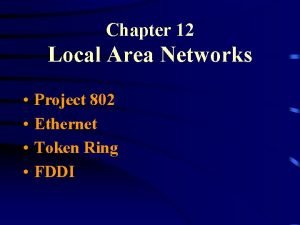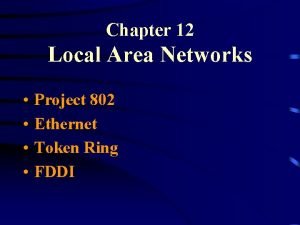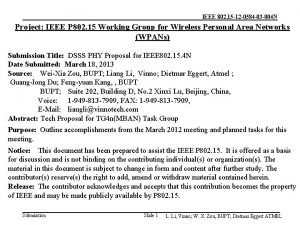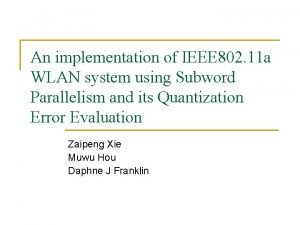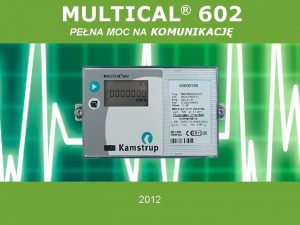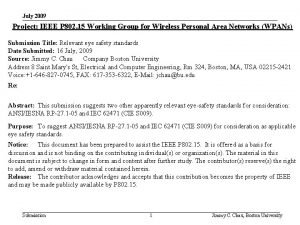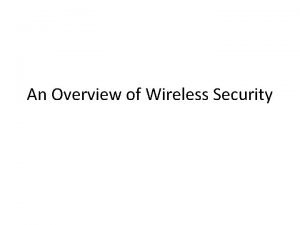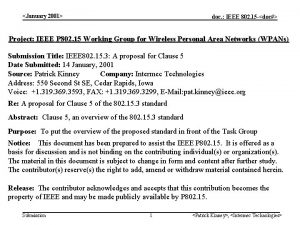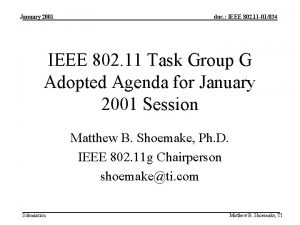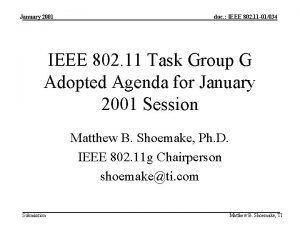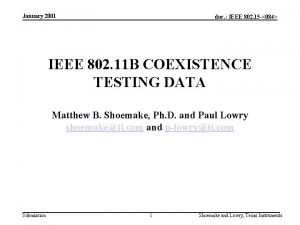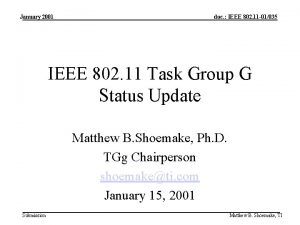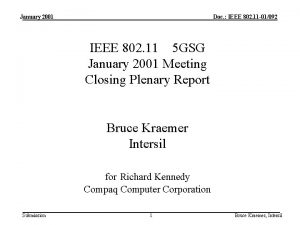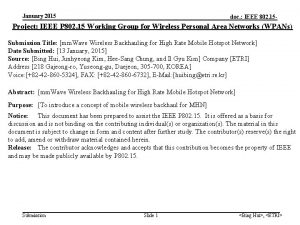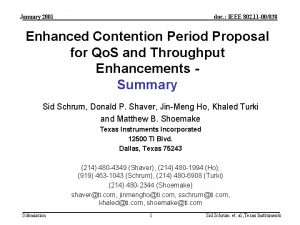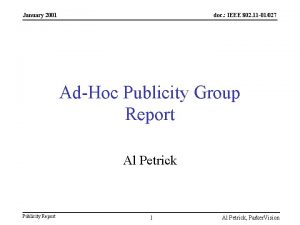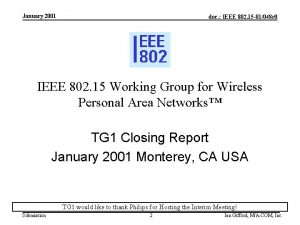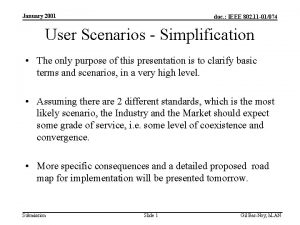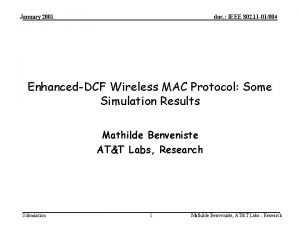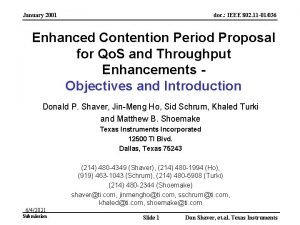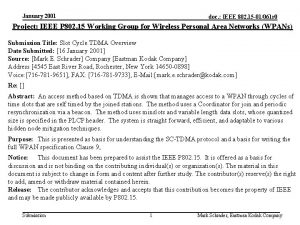January 2001 doc IEEE 802 15 doc Project




















- Slides: 20

<January 2001> doc. : IEEE 802. 15 -<doc#> Project: IEEE P 802. 15 Working Group for Wireless Personal Area Networks (WPANs) Submission Title: IEEE 802. 15. 3: A proposal for Clause 5 Date Submitted: 14 January, 2001 Source: Patrick Kinney Company: Intermec Technologies Address: 550 Second St SE, Cedar Rapids, Iowa Voice: +1. 319. 369. 3593, FAX: +1. 319. 369. 3299, E-Mail: pat. kinney@ieee. org Re: A proposal for Clause 5 of the 802. 15. 3 standard Abstract: Clause 5, an overview of the 802. 15. 3 standard Purpose: To put the overview of the proposed standard in front of the Task Group Notice: This document has been prepared to assist the IEEE P 802. 15. It is offered as a basis for discussion and is not binding on the contributing individual(s) or organization(s). The material in this document is subject to change in form and content after further study. The contributor(s) reserve(s) the right to add, amend or withdraw material contained herein. Release: The contributor acknowledges and accepts that this contribution becomes the property of IEEE and may be made publicly available by P 802. 15. Submission 1 <Patrick Kinney>, <Intermec Technologies>

<January 2001> doc. : IEEE 802. 15 -<doc#> Clause 5 An Overview of the 802. 15. 3 PAN Submission 2 <Patrick Kinney>, <Intermec Technologies>

<January 2001> doc. : IEEE 802. 15 -<doc#> General Description of the Architure • How wireless PAN systems are different from LANs – very limited power, small size, short range – Destination address does not equal destination location – The medium impacts the design • • Submission unreliable medium including interference dynamic topology no full connectivity time varying, asymmetric propagation 3 <Patrick Kinney>, <Intermec Technologies>

<January 2001> doc. : IEEE 802. 15 -<doc#> Components of the IEEE 802. 15. 3 PAN STA A STA B Coordinator • Personal Operating Space – While defined as up to 10 meters the actual coverage boundaries are not well defined and could be time variant Submission 4 <Patrick Kinney>, <Intermec Technologies>

<January 2001> doc. : IEEE 802. 15 -<doc#> Components of the IEEE 802. 15. 3 PAN • IEEE 802. 15. 3 PANs are Ad Hoc – typically without preplanning – no uniquely defined Access Point • Integration with other Networks – Portal: the logical point at which external MSDUs enter the PAN, or vice versa – any station, including the coordinator, may serve as a portal Submission 5 <Patrick Kinney>, <Intermec Technologies>

<January 2001> doc. : IEEE 802. 15 -<doc#> 802. 15. 3 PAN with portals W-WAN 802. 15. 1 PAN STA A STA B Coordinator 802. 11 W-LAN Submission 6 <Patrick Kinney>, <Intermec Technologies>

<January 2001> doc. : IEEE 802. 15 -<doc#> Overview of Services • Coordination – transmission of beacons containing timing and information describing the PAN – allocation of bandwidth • Authentication – stations wishing to join must first authenticate with the coordinator, then with each desired station – Public Key exchange • open or controlled Submission 7 <Patrick Kinney>, <Intermec Technologies>

<January 2001> doc. : IEEE 802. 15 -<doc#> Overview of Services • Data Transport: Three mechanisms – Asynchronous in the Contention Access Period – Asynchronous in the Contention Free Period – Synchronous in the Contention Free Period • Qo. S – coordinator manages bandwidth – temporarily unused bandwidth is made available to other streams Submission 8 <Patrick Kinney>, <Intermec Technologies>

<January 2001> doc. : IEEE 802. 15 -<doc#> Overview of Services • Power Management – stations can transmit data during the CAP, they need not use CFP – stations not participating in CFP need not be active during CFP – in CAP, RTS window is used to notify the station of a pending message Submission 9 <Patrick Kinney>, <Intermec Technologies>

<January 2001> doc. : IEEE 802. 15 -<doc#> Overview of Services • Transfer of Coordination – coordinator can participate in this process actively or passively. – Active: coordinator agrees with another station that the other station is better suited – Passive: coordinator “disappears” ie gets turned off or is moved outside the POS Submission 10 <Patrick Kinney>, <Intermec Technologies>

<January 2001> doc. : IEEE 802. 15 -<doc#> Overview of Operation • Superframe • Overview of States Submission 11 <Patrick Kinney>, <Intermec Technologies>

<January 2001> doc. : IEEE 802. 15 -<doc#> Beacon Superframe Contention Access Period RTS Contention Free Period Data Asynchronous slots Isochronous slots • Beacon contains timing and information about the PAN Submission 12 <Patrick Kinney>, <Intermec Technologies>

<January 2001> doc. : IEEE 802. 15 -<doc#> Beacon Contention Access Period RTS Contention Free Period Data • CAP is used to send Qo. S requests/grants and some data as well as authentication requests/grants • RTS window is used to assist power management by requesting a station to stay awake during the data window • Data window is used for short data transfers, unicast requires an ACK Submission 13 <Patrick Kinney>, <Intermec Technologies>

<January 2001> doc. : IEEE 802. 15 -<doc#> Beacon Contention Free Period Contention Access Period RTS Contention Free Period Data Asynchronous slots Isochronous slots • CFP is composed of data streams with quality of service provisions • Stations may only use CFP if the coordinator has evaluated the current usage along with the request for new service and determines that sufficient bandwidth is available Submission 14 <Patrick Kinney>, <Intermec Technologies>

<January 2001> doc. : IEEE 802. 15 -<doc#> CFP: Slots Cycles Mini-slot • Each slot may be composed of many cycles, each cycle assigned to a stream • All stations will count frames and use those slots and cycles that have been assigned to that station’s streams • A mini-slot occurs when a station doesn’t have data to send, the next stream may use this bandwidth Submission 15 <Patrick Kinney>, <Intermec Technologies>

<January 2001> doc. : IEEE 802. 15 -<doc#> Overview of States • Establishment of PAN – establishes duration of superframe – allocation between CAP and CFP • Joining – station listens for beacon – station attempts to authenticate with coordinator during CAP – station will receive a secret key upon successful authentication – station exchanges capability information with coordinator Submission 16 <Patrick Kinney>, <Intermec Technologies>

<January 2001> doc. : IEEE 802. 15 -<doc#> Overview of States • Stream Establishment – station requests connection from coordinator during CAP – coordinator will assign a slot/cylce identifier if required bandwidth is available – station will use CFP at next superframe – stream can be from any station to any station Submission 17 <Patrick Kinney>, <Intermec Technologies>

<January 2001> doc. : IEEE 802. 15 -<doc#> Overview of States • Data Exchange – can occur in CAP or CFP – CAP should be restricted to small transfers – in CAP if destination is not known to be powered up, RTS window will be used with data transfer only if destination responds – RTS/CTS can be used if hidden nodes are suspected – data can be transferred from any station to any station (peer to peer) Submission 18 <Patrick Kinney>, <Intermec Technologies>

<January 2001> doc. : IEEE 802. 15 -<doc#> Overview of States • Coordination Transfer – coordinator can transfer if another station is better suited or if coordinator cannot continue • Network Termination – can be requested by a station or by coordinator’s management – coordinator will broadcast termination command – or you could just pop the batteries out Submission 19 <Patrick Kinney>, <Intermec Technologies>

<January 2001> doc. : IEEE 802. 15 -<doc#> ISSUES • Transfer of coordination: loss of service arrangements? • Do we authenticate with every station? • Do we have a mode of authenticating only with coordinator? • Do we then allow a single shared private key for network? • Multiple data rates within a PAN? Submission 20 <Patrick Kinney>, <Intermec Technologies>











